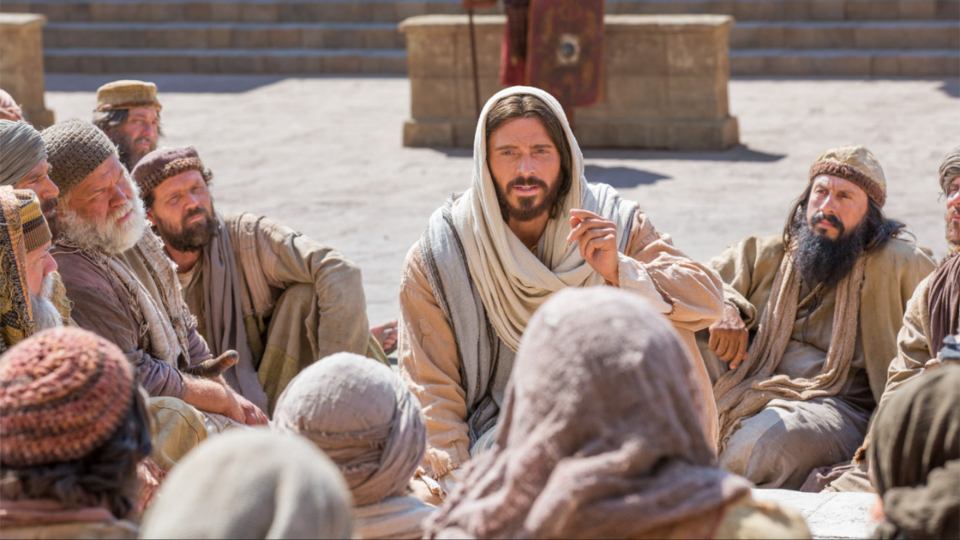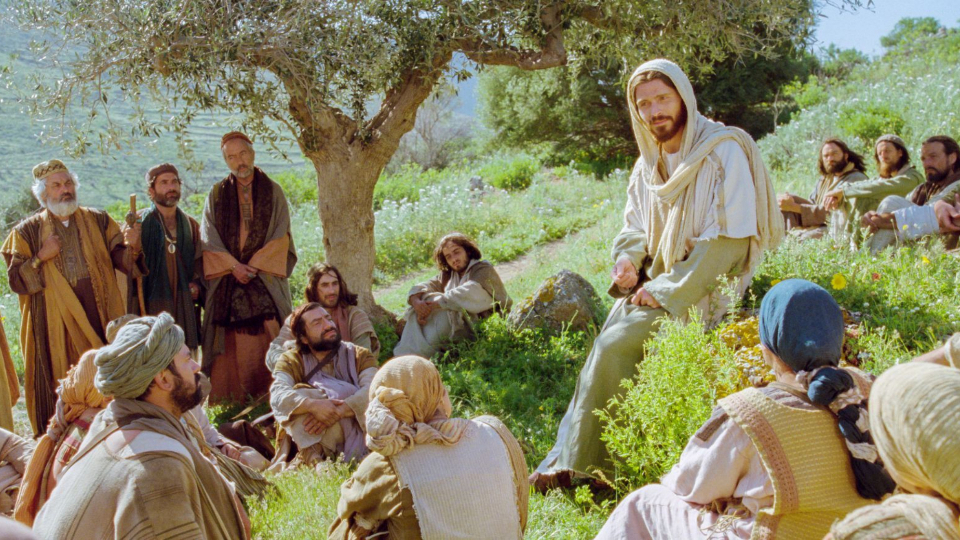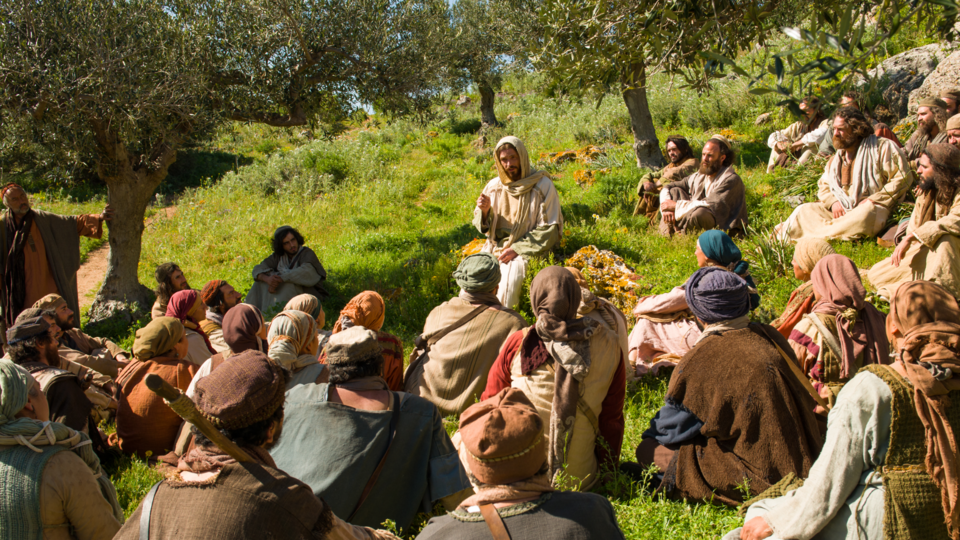
Parables
A depiction from the Church's Bible Videos Series of Jesus Christ teaching his apostles and others using parables . 2023 by Intellectual Reserve, Inc. All rights reserved.
This story appears here courtesy of TheChurchNews.com. It is not for use by other media.
By Trent Toone, Church News
Brigham Young University professor Gaye Strathearn likes to provide her students with a simple definition for the parables of Jesus Christ.
“Parables are earthly stories with heavenly meanings,” said Strathearn, who teaches in BYU’s Department of Ancient Scripture and the Ancient Near East Studies program.
“I really like that definition because parables are very much set in the common, everyday life experience of the people Jesus was talking to. Of course, Jesus wasn’t the only one to teach in parables, but there is a meaning that transcends the earthly experience in the message.”
During his mortal ministry, the Savior used parables to engage his listeners who understood the meaning at different levels.
“Parables are a defining feature of the Lord Jesus Christ’s masterful approach to teaching,” Elder David A. Bednar of the Quorum of the Twelve Apostles taught. “Simply defined, the Savior’s parables are stories used to compare spiritual truths with material things and mortal experiences” (“Put On Thy Strength, O Zion,” October 2022 general conference).
What Jesus Said About Parables
In Matthew 13:10, the disciples ask the Savior, “Why speakest thou unto them in parables?”
Jesus responded: “Who hath ears to hear, let him hear. ... Therefore speak I to them in parables: because they seeing see not; and hearing they hear not, neither do they understand. And in them is fulfilled the prophecy of Esaias, which saith, by hearing ye shall hear, and shall not understand; and seeing ye shall see, and shall not perceive. For this people’s heart is waxed gross, and their ears are dull of hearing, and their eyes they have closed; lest at any time they should see with their eyes, and hear with their ears, and should understand with their heart, and should be converted, and I should heal them” (Matthew 13: 9, 13-15).

SS-CFM-2023
An image from the Church’s Bible video series depicts Jesus teaching a group of people.2022 by Intellectual Reserve, Inc. All rights reserved.
In Matthew 13:11, the Savior also said it is given to some to know the “mysteries of the kingdom of heaven.” Strathearn doesn’t want anyone to misunderstand the term, “mysteries.”
“A mystery is anything that needs help interpreting or understanding,” Strathearn said. “As Latter-day Saints, we talk about the gospel as ‘beautifully simple and simply beautiful,’ and that’s true at a certain level. But at another level it is deeply complex.”
The Lord sees eternally while people are wired for the here and now with a limited perspective, the professor said.
“My brain can’t get around eternity. I get little glimpses of it here and there, but the whole totality of it, I struggle to feel comfortable in my ability to understand and appreciate that, and I think Jesus understood that,” Strathearn said. “He’s starting where they are at, but He’s expecting His teachings to stretch them. He has considered deeply what He is saying for people wherever they are in their spiritual journey.”
Strathearn offered four keys to understanding the Savior’s parables as members of The Church of Jesus Christ of Latter-day Saints prepare to study the New Testament in 2023 through its “Come, Follow Me” curriculum.
1. Use Joseph Smith’s Key to Understanding Parables
The first insight comes from the discourses of the Prophet Joseph Smith:
“I have a key by which I understand the scriptures. I enquire, what was the question which drew out the answer, or caused Jesus to utter the parable? ... To ascertain its meaning, we must dig up the root and ascertain what it was that drew the saying out of Jesus.”
Strathearn examined Luke 10’s parable of the Good Samaritan as an example. The first question is found in verse 25 when a certain lawyer asks the Master what he must do to “inherit eternal life.” Jesus answers with the two good commandments, love God and love your neighbor. The lawyer then asks, “Who is my neighbor?” which prompts the parable.
“So if the question is ‘What do I have to do to achieve eternal life?’ at least in this perspective, it’s being a good samaritan,” she said. “But if we divorce it from that question, or those questions, then we miss something really important.”
2. Understand the Context of What Is Happening
The second insight is similar to the first — examine the parable in the context of what is happening in the chapter as a whole.
Luke 15 features three parables about lost items — the lost sheep, the lost coin and the prodigal son.
Strathearn pointed to the chapter’s opening verses, in which the pharisees and scribes criticize the Savior for spending time with sinners.
“With that context, that suggests to us as readers that this how we should be understanding the lost sheep, the lost coin and the lost son, that we should be actively going out and looking for people who are lost, not just hanging around with like-minded people,” she said.
3. Consider the Author’s Intent
Readers might also consider what the author was trying to do with the parables.
Matthew, Mark and Luke all testify of Jesus, but speak to different people and use the parables to teach different principles. Matthew had a way of gathering things into a chapter, such as grouping Jesus’s miracles into chapters 8 and 9, while Mark and Luke spread the miracles throughout the Savior’s ministry, Strathearn said.
“Matthew has gathered them there because he wants to teach something specific. It’s the same with chapter 13. This isn’t Jesus going on a parable-teaching spree, this is Matthew as editor collecting them for specific reason,” the professor said.
She cited several verses in chapter 13 that all reference the phrase, “The kingdom of heaven is.” What has Matthew collected and what is he trying to teach? “He’s trying to teach the kingdom of heaven,” Strathearn said.
4. Allow for a Variety of Interpretations
Sometimes the reader is given the interpretation of a parable, but it doesn’t mean there aren’t other possible explanations.
Strathearn said parables were meant to help people on different spiritual levels, so there could be multiple interpretations.
“We cheat ourselves when we are happy to come up with a single answer and say this is what it means,” Strathearn said. “In my mind, there is no one way to interpret a parable. If that’s all we are willing to concede, it cheapens the parables and the powerful tool that they were for Jesus to use.”
The parable of the lost sheep is recorded by both Matthew (18:10–14) and Luke (15:3–7). But Jesus uses the parable in these two accounts for different purposes. In Matthew, the parable is used as part of Jesus’s response to the question, “Who is the greatest in the kingdom of heaven?” (18:1). In Luke, however, the parable is used to teach why Jesus eats with sinners.

jesus teaches parables
A depiction from the Church's Bible Videos Series of Jesus Christ teaching people using parables on the Mount of Olives.2020 by Intellectual Reserve, Inc. All rights reserved.
“So in each of these cases, any interpretation of the parable of the lost sheep should take into consideration what Jesus is trying to teach when he gives the parable,” she said.
“I encourage us to think about the multitude of ways the parables can be understood and helpful in understanding these things of eternity.”
The late President Thomas S. Monson told many stories and true accounts in speaking to Church members for more than 50 years as an Apostle and Church president. Some of his accounts, told more than once, might be modern-day parables.
“One of the things I learned is he might be telling the same story, but he’s not always giving the same message,” Strathearn said. “President Monson taught this story once and this is what it meant, then that doesn’t account for the wonderful ways he used it and the depth of the ways he used it.”
What Gaye Strathearn Has learned From Parables
For Strathearn, studying the parables have given her a window into her own soul to help her see ways that she needs to do better.
“They make me squirm a little bit,” she said.

New-Testament-parables
BYU professor Gaye Strathearn teaches in BYU’s Department of Ancient Scripture and the Ancient Near East Studies program. Photo courtesy of Gaye Strathearn, courtesy of Church News.2023 by Intellectual Reserve, Inc. All rights reserved.It’s easy for Strathearn to read the parable of the sower and assume that as a Latter-day Saint, she’s planted in good soil. “That’s a safe way of interpreting that,” she said.
But when the professor reads about the way side soil, the stony ground and the thorns, along with interpretations by Church leaders, it feels less safe and she knows she must improve and do better.
“Studying the parables, I think, has helped me to become less comfortable with where I’m at spiritually (not in a negative way),” the professor said. “It has helped me to not be complacent, to know that eternity is large, broad and deep. And it’s worth opening the doors to learn more about it.”
“So in each of these cases, any interpretation of the parable of the lost sheep should take into consideration what Jesus is trying to teach when he gives the parable,” she said.
“I encourage us to think about the multitude of ways the parables can be understood and helpful in understanding these things of eternity.”
Copyright 2022 Deseret News Publishing Company.